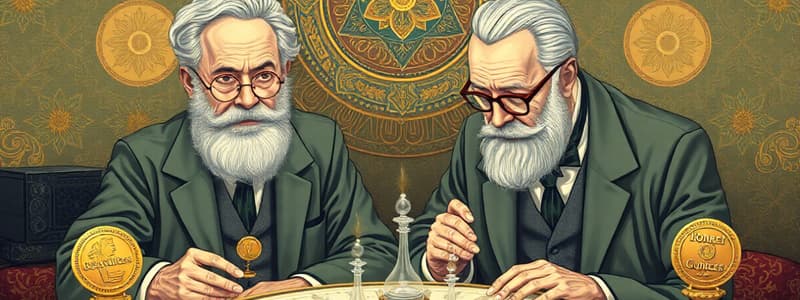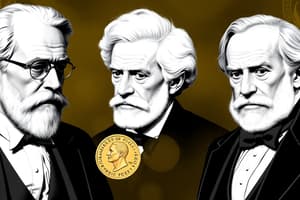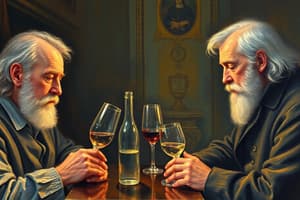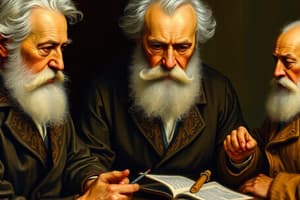Podcast
Questions and Answers
Which scientist made significant contributions to understanding the structure of ionic crystals?
Which scientist made significant contributions to understanding the structure of ionic crystals?
Who is credited with developing the first computer-based weather predictions?
Who is credited with developing the first computer-based weather predictions?
Which scientist's work was instrumental in the development of a polio vaccine?
Which scientist's work was instrumental in the development of a polio vaccine?
Who pioneered the concept of space telescopes?
Who pioneered the concept of space telescopes?
Signup and view all the answers
Which scientist was awarded the Nobel Prize for their research on the tobacco mosaic virus?
Which scientist was awarded the Nobel Prize for their research on the tobacco mosaic virus?
Signup and view all the answers
Who developed techniques for in vitro fertilization (IVF)?
Who developed techniques for in vitro fertilization (IVF)?
Signup and view all the answers
What scientist determined the structure of carbon atoms in benzene?
What scientist determined the structure of carbon atoms in benzene?
Signup and view all the answers
What did Rita Levi-Montalcini discover that led to her being awarded the Nobel Prize?
What did Rita Levi-Montalcini discover that led to her being awarded the Nobel Prize?
Signup and view all the answers
Who made significant contributions to the design and development of early high-speed electronic digital computers?
Who made significant contributions to the design and development of early high-speed electronic digital computers?
Signup and view all the answers
Which scientist made pioneering measurements of radio emissions from the Sun and stars?
Which scientist made pioneering measurements of radio emissions from the Sun and stars?
Signup and view all the answers
Flashcards
Linus Pauling
Linus Pauling
Chemist and Nobel laureate known for quantum mechanics and chemical bonding.
Quantum Mechanics
Quantum Mechanics
A fundamental theory in physics describing the physical properties of nature at the scale of atoms and subatomic particles.
John von Neumann
John von Neumann
Pioneer in computer science and created early digital computers and weather models.
Nerve Growth Factors
Nerve Growth Factors
Signup and view all the flashcards
Wendell Stanley
Wendell Stanley
Signup and view all the flashcards
Ruby Payne-Scott
Ruby Payne-Scott
Signup and view all the flashcards
Polio Vaccine
Polio Vaccine
Signup and view all the flashcards
Space Telescopes
Space Telescopes
Signup and view all the flashcards
In Vitro Fertilization (IVF)
In Vitro Fertilization (IVF)
Signup and view all the flashcards
Kathleen Lonsdale
Kathleen Lonsdale
Signup and view all the flashcards
Study Notes
Linus Pauling
- Chemist Linus Pauling, born in Portland, Oregon, won two Nobel Prizes - one for Chemistry and one for Peace
- He attempted to mediate conflicts between the US and Vietnam
- His book "The Nature of the Chemical Bond" is influential
- He established rules for ionic crystal structure
- He described how atomic orbitals combine in covalent compounds
John von Neumann
- Hungarian-born mathematician, known for his contributions to early digital computers
- Developed early high-speed electronic digital computers
- Developed the von Neumann architecture, a model for computers to store programs and data
- Involved in the first computer-based weather predictions with American meteorologist Jule Charney.
Rita Levi-Montalcini
- Faced challenges due to her gender but became successful in her studies
- Made significant discoveries about nerve growth factors (NGFs). Subsequently, studied medicine at the University of Turin
- Became a professor at Washington University
- Demonstrated that NGFs were crucial in various diseases, including Alzheimer's and cancer.
- Shared the 1986 Nobel Prize in Physiology or Medicine for her work on NGFs with Stanley Cohen.
Wendell Stanley
- Determined the molecular structure of viruses via X-ray diffraction.
- Shared the 1946 Nobel Prize in Chemistry for his research on the tobacco mosaic virus.
- Contributed to the development of a vaccine against influenza.
- His understanding of viruses helped in developing a polio vaccine.
Ruby Payne-Scott
- Australian radio physicist who worked in the 1940s and 1950s.
- One of the few women in radiophysics.
- Worked for the Radiophysics Laboratory at the University of Sydney.
- Contributed to radar development for Australia's coastline, and developed means to measure radio emissions from the Sun and stars.
Jonas Salk
- American virologist who developed the first safe and effective polio vaccine.
- The vaccine used killed viruses, avoiding live viruses.
- This vaccine led to the large-scale vaccination of millions against polio.
- His vaccine was successful but not effective in the long run
Lyman Spitzer Jr.
- US astrophysicist who first conceived the idea of space telescopes
-
- Created the concept and proposed that telescopes could be placed in space.
- Successfully campaigned for funding for the Hubble Space Telescope, addressing concerns about detecting non-visible radiation in Earth's atmosphere
Robert Edwards
- British physiologist who developed the "test-tube" pregnancy techniques.
- Created the right conditions for egg fertilization outside the womb.
- Collaborated with surgeon Patrick Steptoe
- His work culminated in the first "test-tube baby" in 1978.
- Awarded the Nobel Prize in Physiology or Medicine in 2010.
Kathleen Lonsdale
- Worked under William Henry Bragg at the Royal Institution, London.
- Developed X-ray techniques for studying chemical compound structures.
- Determined that benzene atoms have a hexagonal ring arrangement.
- Became a fellow of the Royal Society, making her one of the first women admitted
Studying That Suits You
Use AI to generate personalized quizzes and flashcards to suit your learning preferences.
Description
Explore the remarkable contributions of Linus Pauling, John von Neumann, and Rita Levi-Montalcini. Discover Pauling's work in chemistry and peace, von Neumann's pivotal advancements in computing, and Levi-Montalcini's groundbreaking research on nerve growth factors. This quiz highlights their legacies and influence on science and technology.





